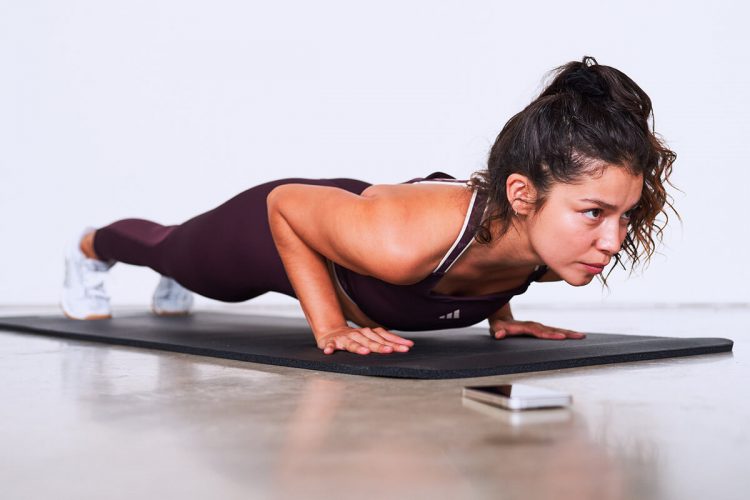Do you struggle with doing push-ups? Does it feel impossible to do even just one? Push-ups are especially tough when you first attempt to do them. There are also a lot of push-up variations, so knowing where to begin can be quite confusing.
But don’t let this stop you from reaching your goals! You simply need the right exercises, like the incline push-up, to know how to get better at pushups and progress from a beginner to a master.
The following info will help you learn how to do push-ups by
- learning the proper push-up form
- preparing your body to do push-ups correctly
- practicing the incline push-up; push-ups for beginners
Table of contents:
Proper push-up form
Knowing how to do a proper push-up is beneficial for your fitness and health. They’re an awesome addition to any fitness program, no matter your specific goals – including a runner’s performance.
If done correctly, push-ups are a super effective compound exercise that uses the core, glutes, and lower back muscles while strengthening your pectorals, triceps, and deltoids.
But improper form can cause damage to your joints.
It’s not unusual to perform push-ups incorrectly, especially as a beginner. Common mistakes that should be avoided are
- flared elbows
- back to straight
- hands positioned in front of the shoulders
Tucked elbows
When lowering your body towards the floor, your elbows should be pulled in closer to the body rather than flared out away from you.
This movement requires strength and practice, so starting with an inclined wall push-up is a great way to practice the movement while building the strength needed to perform a push-up correctly.
Straight back & engaged core
To perform a push-up, you begin in the plank position, making sure your core is engaged and your belly button is pulled in toward your spine. An engaged core will prevent your hips from sagging toward the floor and your back to not be straight, which can cause injury.
Correct hand position for push-ups
Start by placing your hands under your shoulders with the index fingers pointing forward. For more stability, press the palms of your hands firmly onto the floor, which will help to stabilize your arms and shoulders.
Step 1: Prepare with the plank
Since a push-up begins in a plank position, it’s a great starting place to practice a push-up. Holding a 60–second high plank with good form engages many of the same muscles used in a push-up – like your core, glutes, lower back, and shoulders.
<span data-mce-type=”bookmark” style=”display: inline-block; width: 0px; overflow: hidden; line-height: 0;” class=”mce_SELRES_start”> </span>
Begin with planks and build up to the push-up routine below.
Step 2: Practice push-ups
Beyond planks, there are a few exercises that help you build strength and practice good push-up form as you work your way up to performing full push-ups.
<span data-mce-type=”bookmark” style=”display: inline-block; width: 0px; overflow: hidden; line-height: 0;” class=”mce_SELRES_start”> </span>
The simplest way to progress from a plank position to a full push-up is to consistently train your body with incline push-ups.
Knee push-ups can help you practice your form as well, building upper body strength, but the position greatly differs from the actual form of the push-up as your upper body is most impacted, and the core, back, and glutes are less activated.
<span data-mce-type=”bookmark” style=”display: inline-block; width: 0px; overflow: hidden; line-height: 0;” class=”mce_SELRES_start”> </span>
We recommend practicing incline push-ups to learn how to do a full push-up.
The Incline Push-up
An incline push-up is a variation of the push-up where your upper body is supported on a higher surface than your toes. It works the upper body muscles (chest, shoulders, triceps & back muscles) and requires core stability as well. Here are some examples:
How to do the incline push-up routine
- Find an incline. This could be stairs, a desk, or even a wall. Wall push-offs are a variation of the incline push-up that can be especially great for beginners.
- Do as many reps as you can with good form. Rest for 2 minutes and repeat for another two rounds. Strive to do this workout 3 times per week.
- Practice consistently. Continue to do as many reps as you can at the height you began training at until you can do 3 sets of 10 repetitions (3 x 10) with good form – no sagging belly or chest, no sticking out your butt, no flared elbows.
- Lower the height. Progress to a lower height and repeat the same process again.
- Keep reducing the height until you reach the floor. Now you are ready to perform push-ups.
<span data-mce-type=”bookmark” style=”display: inline-block; width: 0px; overflow: hidden; line-height: 0;” class=”mce_SELRES_start”> </span>
This routine is enough to get you to your first Push-up. If you are up for more of a challenge, you can add the following exercise at the end of the incline push-up routine.
Ready to challenge yourself? Try these turning point exercises
Both of these exercises are designed to challenge your strength by pushing your limits. Choose the variation that you like better and repeat it 5-10 times at the end of your incline push-up routine.
- Top down: Get in a high plank position and start to slowly lower your body. Find the lowest point where you can lower your body without collapsing, and are still able to push yourself back up. This can be referred to as your turning point. Hold this position for 3-5 seconds. As you continue to grow stronger, your turning point will increase in depth.
- Bottom up: Position yourself in push-up position, lying down on the floor. Try to push yourself up like you are about to do a push-up. Push yourself as high as you can, even if it’s just 3 cm off the ground. Hold this position for 3-5 seconds.
How to add an incline push-up routine to your workout plan
Adding a push-up routine to your workout plan is simple. The two best options are
- Add the routine to your workout: If your workout plan doesn’t involve many push-ups, add this routine to your workout 2-4 times per week. Do the routine on days when you don’t work your upper body as much in general and allow a rest day between two routines.
- Fitting the routine into your workout plan: If your workout plan already includes knee push-ups and/or push-ups, opt for incline push-ups instead. To start, do the incline variation for as many solid reps as you can on an incline as low as possible. If you’re unable to perform the same amount of reps as your plan includes, finish the set on a higher incline, which is easier.
Final tips on how to train for push-ups
It’s important to stay motivated and acknowledge your achievements as you work towards any fitness goals. Here are three final tips to help you on your journey to full push-ups:
- Be disciplined: Set a goal you can achieve, so you don’t get discouraged. Just stick to the plan. If you know you can’t manage the routine at least 3 times a week, then make the appropriate adjustments to fit your schedule.
- Don’t give up: As you progress with the routine, you will feel stronger and closer to succeeding at your first push-up. Try to incorporate incline push-ups at least once a week, but strive for more. And add them at the start of your workout routine before you’re especially tired.
- Start with one: As soon as you can do one full push-up, start your sets with the full push-up (one or more) and then finish the set with an easier variation like the incline or knee push-up.
When you can do the full push-up easily, it’s time to check out other push-up variations and set yourself a new goal to work toward!
***
Source by www.runtastic.com










